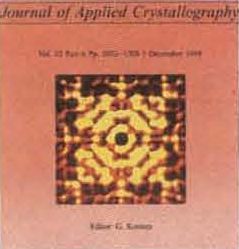


IUCr journals news
Combined experimental techniques and glass ceramics
J. Appl. Cryst. 32 (1999), 1090-1099

![[Structural modifications diagram]](https://www.iucr.org/__data/assets/image/0003/2991/7_4_3.gif) Structural modifications in a CaO-SiO2-ZrO2 glass ceramic as a function of annealing temperature. The devitrification of the system is accompanied by a decrease of the Debye-Waller factors with increasing temperature, indicating that a progressive re-ordering occurs in the bulk glass matrix. The Zr-Si and Zr-Zr coordination numbers increase, indicating a progressive ordering of the Zr environment with temperature.
Structural modifications in a CaO-SiO2-ZrO2 glass ceramic as a function of annealing temperature. The devitrification of the system is accompanied by a decrease of the Debye-Waller factors with increasing temperature, indicating that a progressive re-ordering occurs in the bulk glass matrix. The Zr-Si and Zr-Zr coordination numbers increase, indicating a progressive ordering of the Zr environment with temperature.
To gain insight into the atomic structure of crystalline matter, diffraction techniques and absorption spectroscopy are routinely combined. A problem arises in composite materials where the pair correlation function g(r) is the sum of convolution products between the individual partial pair correlation functions of the atomic constituents. Thus the information obtained from single measurements is difficult – if not impossible – to interpret without ambiguity.Element contrast variation by resonant scattering of X-rays, scattering length differences related to isotope variation for neutrons and contrast enhancement with polarized neutrons can help to solve the problem. Using anomalous small-angle X-ray scattering and differential anomalous wide-angle scattering experiments at an absorption edge of elements in the glass, the individual partial pair correlation functions of these elements become accessible.
Recently, such a 'multitechnique approach' was successfully adopted for the study of the devitrification and recrystallization phenomena in the systems MgO-Al2O3-SiO2 doped with the nucleants TiO2 and ZrO2 [“Phase Formation Kinetics in a Glass Ceramic Studied by Small-Angle Scattering of X-rays and Neutrons and by Visible-Light Scattering”, U. Lembke, R. Brückner, R. Kranold & Th. Höche, J. Appl. Cryst. 30 (1997), 1056-1064] and in the asquenched CaO-SiO2-ZrO2 glass ceramic [“Differential anomalous wide-angle X-ray scattering and X-ray absorption experiments to investigate the formation of glass ceramics in the CaO-SiO2-ZrO2 system”, C. Meneghini, A.F. Gualtieri & C. Siligardi, J. Appl. Cryst. 32 (1999), 1090-1099].
Combinations of resonant and nonresonant small-angle scattering experiments (SAX, ASAX, SANS), transmission electron microscopy, electron microprobe analysis (EDX) and visible-light scattering or X-ray scattering, X-ray absorption spectroscopy (EXAFS) and differential anomalous X-ray scattering experiments led to a detailed picture of the crystallization routes for the two oxide systems. Special attention was paid to the role of ZrO2 and TiO2 additives in the nucleation of crystalline phases. The articles by Meneghini et al. and Lembke et al. show impressively the high level of detailed structural information about the formation of glass ceramics that can be achieved through a combination of experimental techniques where element contrast variation plays a key role.
Rainer Hock, U. of Erlangen, Germany

